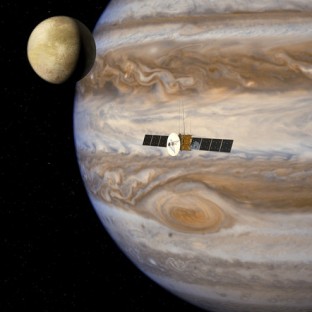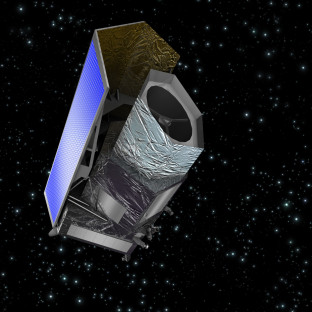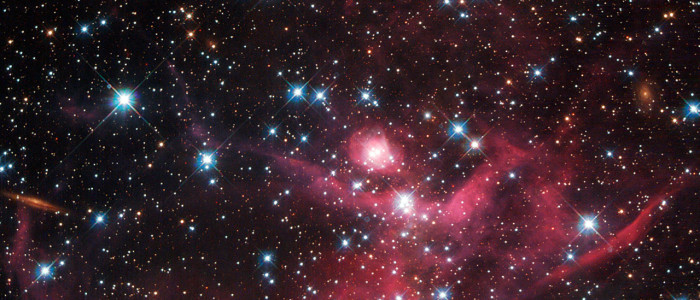
Juice – the first large mission. Credit ESA
In spite of the fact that astronomical observations and calculations have been carried out even before Christ and several centuries of astronomy and space research are way behind us, there are still many things we are not familiar with and space is therefore an important field within basic research
Today, space research is carried out both from Earth and from satellites and probes in space and, in spite of some smaller national projects, organizing of space research in Europe is mainly delegated to the European Space Agency (ESA).
Some scientific projects were carried out during the first years of the establishment of ESA, but the first main plan came with Cornerstone 2000 in 1985 and later, Cornerstone 2000+, providing the main lines towards 2015. After years of preparations “Cosmic Vision. Space Science for Europe 2015 – 2025” was introduced in 2005. This plan, aiming to last from 2015-2025, draws the lines for continuation of the space research for Europe.
In the preparation for the Cosmic Vision ESA announced the “Call for Themes” and 150 proposals for possible themes were received from the whole of Europe. All these proposals gave basis for the final “Cosmic Vision, Space Science for Europe 2015 – 2025”, the main roadmap for European space research based on satellites.
Cosmic Vision is prepared in near contact with the scientific community and reflects the various communities’ wishes for research fields, but it only draws the main lines, the details are worked out within this framework in a continual process within the technical and economical framework that is at their disposal.
The vision is based on four main questions:
- What are the conditions for planet formation and the emergence of life?
- How does the Solar System work?
- What are the fundamental physical laws of the Universe?
- How did the Universe originate and what is it made of?
Cosmic Vision Today

Euclid- the M2 mission, with some Norwegian ideas. Credit: ESA
The running programme is based on a simple economic framework of nearly 400 million Euros (2005) yearly, providing possibilities for several Small Missions (S), three Medium-size Missions (M) and one Large Missions (L) within the timeframe. Launch of already adopted missions (GAIA, LISA Pathfinder, Bepi Colombo, EXOMars) will take place from now and until 2018 and launch of the first missions in the new programme ( S1 and M1) is planned for 2017. M2 will follow in 2018 and M3 in 2021. The first large mission (L1) is planned launched in 2020.
Small Missions
With the choice of the Cheops – CHaracterising ExOPlanets Satellite in 2012, ESA introduced the class Small Missions in addition to the Medium and Large class missions.
Small missions in the Science Programme should be rapidly developed, and at low cost, in order to offer greater flexibility in response to new ideas from the scientific community.
Medium Missions
Medium will be relatively “stand alone missions” within the framework of 470 million Euros.
The selection of the missions M1 and M2 is ended and Solar Orbiter and Euclid were chosen as the first in the class. The selection process for M3 is also on its way, but the final choice is not yet decided on. .
Large Missions
The large mission can be carried out in collaboration with other partners and will have an ESA cost not exceeding 900 million Euros.
For the first large mission L1, Jupiter Icy Moons Explorer (JUICE) is selected for 2012.
Featured picture:
This stunning new Hubble image shows a small part of the Large Magellanic Cloud, one of the closest galaxies to our own. This collection of small baby stars, most weighing less than the Sun, form a young stellar cluster known as LH63. This cluster is still half-embedded in the cloud from which it was born, in a bright star-forming region known as the emission nebula LHA 120-N 51, or N51. This is just one of the hundreds of star-forming regions filled with young stars spread throughout the Large Magellanic Cloud. The burning red intensity of the nebulae at the bottom of the picture illuminates wisps of gas and dark dust, each spanning many light-years. Moving up and across, bright stars become visible as sparse specks of light, giving the impression of pin-pricks in a cosmic cloak. This patch of sky was the subject of observation by Hubble’s WFPC2 camera. Looking for and at low-mass stars can help us to understand how stars behave when they are in the early stages of formation, and can give us an idea of how the Sun might have looked billions of years ago. A version of this image was submitted to the Hubble’s Hidden Treasures image processing competition by contestant Luca Limatola.


